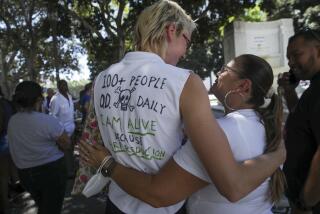Users in Therapy Still Inject Cocaine : High AIDS Infection Rate Found in Treated Addicts
- Share via
STOCKHOLM — Intravenous drug users already in treatment for heroin addiction are becoming infected with the AIDS virus at an alarming rate because they continue to inject cocaine, a San Francisco General Hospital researcher reported Monday.
In the past, public health officials have emphasized intensified efforts to reach intravenous drug users who refused to seek treatment. Now, research suggests that they must also focus on changing the behavior of those already in therapy.
The results also underscore the lack of effective treatment of cocaine addiction and make the development of such treatment a “very urgent” priority in the battle to control the spread of the virus, Dr. Richard E. Chaisson said at the fourth international conference on acquired immune deficiency syndrome.
The new San Francisco study was one of several updates on the status of AIDS virus infections in the United States. One study suggested that the overall rate of infection in the general public may have stabilized in the last couple of years, and another provided new data on long-term follow-up of infected individuals.
Chaisson said the research team found a human immunodeficiency virus (HIV) infection rate of 28% in the drug users who said they injected cocaine daily, compared to an infection rate of 8% in non-cocaine users. The overall infection rate among the 673 drug users studied was 13%.
In the San Francisco General study, the highest rate of AIDS virus infections occurred among blacks, 28% of whom were regular cocaine users. Nearly one-half of blacks who said they injected cocaine daily were infected.
“People who use cocaine are much more likely to use drugs in ‘shooting galleries’ and share needles with other people,” Chaisson said in an interview. Even among people receiving treatment for heroin addiction, the risk of AIDS virus infection “remains quite high because of continued cocaine use.”
“Being on treatment for heroin addiction doesn’t mean you will stop using cocaine,” said Dr. Don C. Deis Jarlais of the New York State Division of Substance Abuse Services.
The San Francisco researchers used confidential questionnaires to obtain data on intravenous drug use habits. About one-third of the people surveyed said they continued to inject cocaine. Many said they had started in 1986, while they were enrolled in methadone treatment programs for heroin addiction.
In another study, the U.S. Centers for Disease Control presented results of the first 18,309 patients tested in its “Sentinel Hospital surveillance network” designed to monitor the levels and trends of HIV infections in the general U.S. population. The early data showed that about three in 1,000 patients from six hospitals, mostly in the Midwest, were infected with HIV.
The data suggest that the overall infection rate in the general population has remained stable in the period studied, between November, 1986, and February, 1988, Dr. Timothy J. Dondero of the CDC said. “The stable rate means (HIV infection) is not exploding,” he said.
The overall 3.3 per 1,000 infection rate suggests that nearly 800,000 Americans are infected with the AIDS virus. This estimate is lower than the estimate of 1 million to 1.5 million infected individuals that CDC has obtained through other studies. However, Dondero said the new surveillance method excludes individuals thought to be at the highest risk of harboring the virus.
In another study, the San Francisco Department of Public Health and the CDC reported that one-third of a group of homosexual men infected with HIV more than an average of seven years ago had developed AIDS.
“The longer you follow people, the higher the percentage that develop AIDS,” said Dr. Harold Jaffe of the CDC. “Nobody has yet to show a plateau where the percent stops increasing.”
More to Read
Sign up for Essential California
The most important California stories and recommendations in your inbox every morning.
You may occasionally receive promotional content from the Los Angeles Times.













